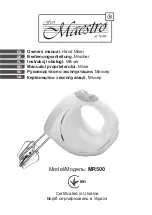
These controls route the input channel signal to any one or more of eight Auxiliary busses. These combine the
sends from each channel, mixing them to separate outputs on the rear of the mixer. Since they are independent
of the main outputs they can provide additional sources for foldback, effects processors or extra loudspeaker ‘fills’.
The controls are specially chosen to give a particularly smooth control range at the lower end of the scale where
it is most needed - quite unique on a mixer of this type. Leave the knobs turned anticlockwise when not in use.
AUX SEND 1 & 2
These sends are always PRE-FADE, PRE EQ and are unaffected by the ON switch. They would typically be used
for Foldback or Monitor feeds, for which it is important that the send should be independent of the fader so that,
for instance, the mix to artists headphones is not affected by changes in fader level.
AUX SEND 3
This send can be pre-fade, pre-EQ and be used in the same way as Aux Sends 1 & 2 for Foldback or as a Monitor
feed, but for Effects it is more appropriate for the Aux Send to fade up and down with the fader (POST-FADE). A
Master Section AUX3 PRE switch allows you to switch all channel Aux 3 sends from pre- to post-fade across the
whole mixer as required. The send is unaffected by the position of the ON switch if the master section Aux 3 PRE
is pressed.
AUX SENDS 4-8
These are always POST-FADE and would normally be used to drive effects processing units which are fed back
into the mixer and which must fade out with the input channel.
Aux 4 is an individual mono send, while the 5/6 STE knob feeds the channel signal via the PAN control (see below)
as a stereo pair to either Aux outputs 5 & 6 or, with the 7-8 switch pressed, to Aux outputs 7 & 8.
PAN
This control sets the amount of the channel signal feeding the Right and Left MIX or GROUP outputs, allowing you
to move the source smoothly across the stereo image. Rotation fully anticlockwise feeds the signal solely to the
Left mix bus, Group 1 or Group 3, while rotation clockwise sweeps the image to the right bus, Group 2 or Group
4.
ON SWITCH
The ON switch enables all post-fade outputs from the channel when pressed. Note that the Insert point is unaffected
by the ON switch.
OUTPUT ROUTING
The input channel signal is always routed to MIX or GROUPS as selected by the two ROUTING switches. The
upper switch selects MIX when released or GROUPS when pressed, while the lower switch chooses between
Groups 1-2 when released or Groups 3-4 when pressed.
PEAK INDICATOR
This LED indicator warns when an excessively high signal level is present in the channel. The signal is sampled
immediately after the EQ section and the LED will illuminate approximately 4dB before clipping. It will therefore
take into account the effect of any equipment connected to the Insert point.
PFL
When the latching PFL switch is pressed, the pre-fade signal is fed to the headphones or monitor outputs, replacing
the selected source (either Mix or Tape Return). The PFL/AFL LED on the Master section illuminates to warn that
the headphones, monitor outputs and right PPM meter are now responding to the PFL/AFL selection. This is a
useful way of listening to any one or more signals without interrupting the main mix, for adjusting signal quality or
simply to check that it is there! You would also use the PFL switch to set the input GAIN as explained under ‘Initial
Setting Up’.
FADER
SPIRIT FOLIO 4
15













































